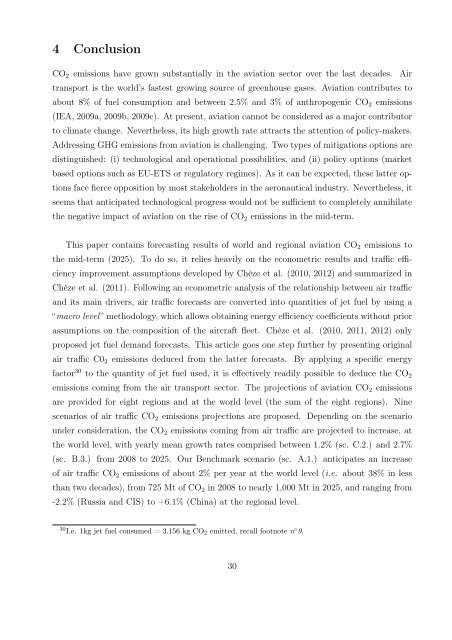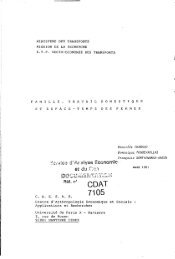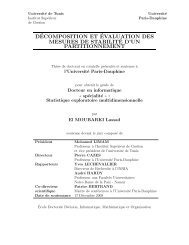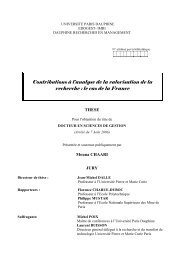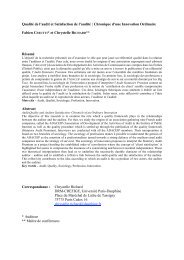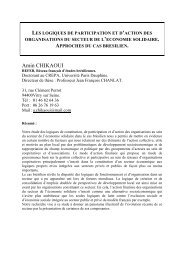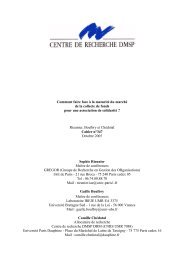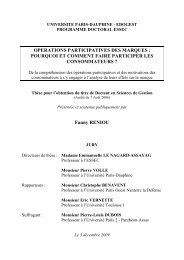12-02-Cahier-R- ... e-Chevallier-Gastineau.pdf - Base ...
12-02-Cahier-R- ... e-Chevallier-Gastineau.pdf - Base ...
12-02-Cahier-R- ... e-Chevallier-Gastineau.pdf - Base ...
You also want an ePaper? Increase the reach of your titles
YUMPU automatically turns print PDFs into web optimized ePapers that Google loves.
4 Conclusion<br />
CO2 emissions have grown substantially in the aviation sector over the last decades. Air<br />
transport is the world’s fastest growing source of greenhouse gases. Aviation contributes to<br />
about 8% of fuel consumption and between 2.5% and 3% of anthropogenic CO2 emissions<br />
(IEA, 2009a, 2009b, 2009c). At present, aviation cannot be considered as a major contributor<br />
to climate change. Nevertheless, its high growth rate attracts the attention of policy-makers.<br />
Addressing GHG emissions from aviation is challenging. Two types of mitigations options are<br />
distinguished: (i) technological and operational possibilities, and (ii) policy options (market<br />
based options such as EU-ETS or regulatory regimes). As it can be expected, these latter op-<br />
tions face fierce opposition by most stakeholders in the aeronautical industry. Nevertheless, it<br />
seems that anticipated technological progress would not be sufficient to completely annihilate<br />
the negative impact of aviation on the rise of CO2 emissions in the mid-term.<br />
This paper contains forecasting results of world and regional aviation CO2 emissions to<br />
the mid-term (2<strong>02</strong>5). To do so, it relies heavily on the econometric results and traffic effi-<br />
ciency improvement assumptions developed by Chèze et al. (2010, 20<strong>12</strong>) and summarized in<br />
Chèze et al. (2011). Following an econometric analysis of the relationship between air traffic<br />
and its main drivers, air traffic forecasts are converted into quantities of jet fuel by using a<br />
“macro level” methodology, which allows obtaining energy efficiency coefficients without prior<br />
assumptions on the composition of the aircraft fleet. Chèze et al. (2010, 2011, 20<strong>12</strong>) only<br />
proposed jet fuel demand forecasts. This article goes one step further by presenting original<br />
air traffic C<strong>02</strong> emissions deduced from the latter forecasts. By applying a specific energy<br />
factor 30 to the quantity of jet fuel used, it is effectively readily possible to deduce the CO2<br />
emissions coming from the air transport sector. The projections of aviation CO2 emissions<br />
are provided for eight regions and at the world level (the sum of the eight regions). Nine<br />
scenarios of air traffic CO2 emissions projections are proposed. Depending on the scenario<br />
under consideration, the CO2 emissions coming from air traffic are projected to increase, at<br />
the world level, with yearly mean growth rates comprised between 1.2% (sc. C.2.) and 2.7%<br />
(sc. B.3.) from 2008 to 2<strong>02</strong>5. Our Benchmark scenario (sc. A.1.) anticipates an increase<br />
of air traffic CO2 emissions of about 2% per year at the world level (i.e. about 38% in less<br />
than two decades), from 725 Mt of CO2 in 2008 to nearly 1,000 Mt in 2<strong>02</strong>5, and ranging from<br />
-2.2% (Russia and CIS) to +6.1% (China) at the regional level.<br />
30 I.e. 1kg jet fuel consumed = 3.156 kg CO2 emitted, recall footnote n ◦ 9.<br />
30


